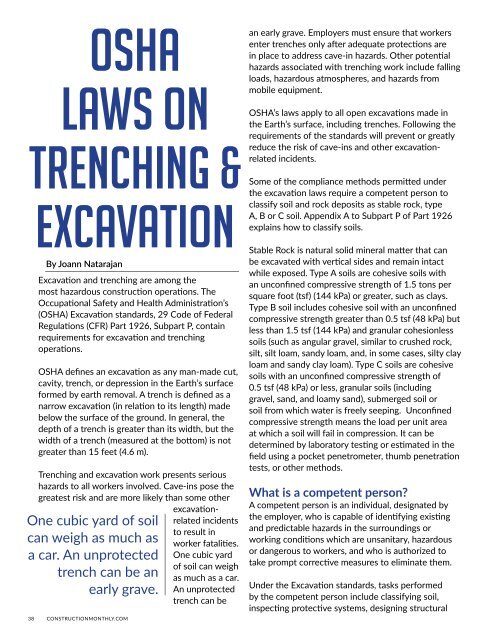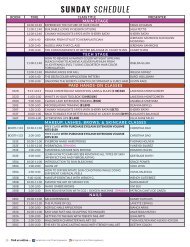Austin 2020 Construction Monthly
You also want an ePaper? Increase the reach of your titles
YUMPU automatically turns print PDFs into web optimized ePapers that Google loves.
OSHA<br />
Laws on<br />
Trenching &<br />
Excavation<br />
By Joann Natarajan<br />
Excavation and trenching are among the<br />
most hazardous construction operations. The<br />
Occupational Safety and Health Administration’s<br />
(OSHA) Excavation standards, 29 Code of Federal<br />
Regulations (CFR) Part 1926, Subpart P, contain<br />
requirements for excavation and trenching<br />
operations.<br />
OSHA defines an excavation as any man-made cut,<br />
cavity, trench, or depression in the Earth’s surface<br />
formed by earth removal. A trench is defined as a<br />
narrow excavation (in relation to its length) made<br />
below the surface of the ground. In general, the<br />
depth of a trench is greater than its width, but the<br />
width of a trench (measured at the bottom) is not<br />
greater than 15 feet (4.6 m).<br />
One cubic yard of soil<br />
can weigh as much as<br />
a car. An unprotected<br />
trench can be an<br />
early grave.<br />
38 CONSTRUCTIONMONTHLY.COM<br />
Trenching and excavation work presents serious<br />
hazards to all workers involved. Cave-ins pose the<br />
greatest risk and are more likely than some other<br />
excavationrelated<br />
incidents<br />
to result in<br />
worker fatalities.<br />
One cubic yard<br />
of soil can weigh<br />
as much as a car.<br />
An unprotected<br />
trench can be<br />
an early grave. Employers must ensure that workers<br />
enter trenches only after adequate protections are<br />
in place to address cave-in hazards. Other potential<br />
hazards associated with trenching work include falling<br />
loads, hazardous atmospheres, and hazards from<br />
mobile equipment.<br />
OSHA’s laws apply to all open excavations made in<br />
the Earth’s surface, including trenches. Following the<br />
requirements of the standards will prevent or greatly<br />
reduce the risk of cave-ins and other excavationrelated<br />
incidents.<br />
Some of the compliance methods permitted under<br />
the excavation laws require a competent person to<br />
classify soil and rock deposits as stable rock, type<br />
A, B or C soil. Appendix A to Subpart P of Part 1926<br />
explains how to classify soils.<br />
Stable Rock is natural solid mineral matter that can<br />
be excavated with vertical sides and remain intact<br />
while exposed. Type A soils are cohesive soils with<br />
an unconfined compressive strength of 1.5 tons per<br />
square foot (tsf) (144 kPa) or greater, such as clays.<br />
Type B soil includes cohesive soil with an unconfined<br />
compressive strength greater than 0.5 tsf (48 kPa) but<br />
less than 1.5 tsf (144 kPa) and granular cohesionless<br />
soils (such as angular gravel, similar to crushed rock,<br />
silt, silt loam, sandy loam, and, in some cases, silty clay<br />
loam and sandy clay loam). Type C soils are cohesive<br />
soils with an unconfined compressive strength of<br />
0.5 tsf (48 kPa) or less, granular soils (including<br />
gravel, sand, and loamy sand), submerged soil or<br />
soil from which water is freely seeping. Unconfined<br />
compressive strength means the load per unit area<br />
at which a soil will fail in compression. It can be<br />
determined by laboratory testing or estimated in the<br />
field using a pocket penetrometer, thumb penetration<br />
tests, or other methods.<br />
What is a competent person?<br />
A competent person is an individual, designated by<br />
the employer, who is capable of identifying existing<br />
and predictable hazards in the surroundings or<br />
working conditions which are unsanitary, hazardous<br />
or dangerous to workers, and who is authorized to<br />
take prompt corrective measures to eliminate them.<br />
Under the Excavation standards, tasks performed<br />
by the competent person include classifying soil,<br />
inspecting protective systems, designing structural

















